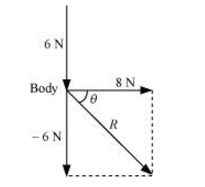




 a" t2
a" t2 Mass of the body, m = 5 kg
The given situation can be represented as follows:
The resultant of two forces is given by,
R = ![]()
![]() is the angle made by R with the force of 8 N.
is the angle made by R with the force of 8 N.
Therefore, ![]()
The negative sign indicates that θ is in the clockwise direction with respect to the force of magnitude 8 N.
According to Newton’s second law of motion
Acceleration (a) of the body is given as,
F = ma
Therefore,
a =![]()
